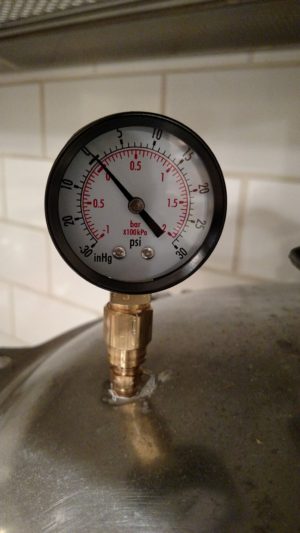
The dread of every low oxygen brewer, even at the commercial scale, is packaging. Previously we spoke of spunding, which is a fantastic way to mitigate the ingress of oxygen for keggers and bottlers alike, but what about filling growlers and bottles for competitions and gifts? It’s an interesting problem, as we are dealing with 2 forms of oxidation in bottle filling, 1.) the initial filling phase, and 2.) the bottle cap ingress phase. While we can’t do much to actually stop the bottle cap ingress phase(short of canning!) we can use methods to minimize oxygen from the initial phase, and use methods we previously talked about like cold fermentation and spunding to maximize our results.
It’s a very tricky proposition to have to fill a bottle when we don’t have active yeast in suspension. Active yeast is such a powerful, natural antioxidant, that losing its abilities at packaging puts us at a disadvantage. There were some theories about adding a simple sugar solution to bottles, but in execution I found a definite flavor loss when doing this. You have to wake the yeast up, and these yeast are already not your top performers. The time frame it takes for those yeast to wake up and try to consume any DO causes flavor loss, which is problematic for a competition beer. Much like any other time that I look for a solution to a problem, the first thing I do is go to Kunze. Kunze is well aware of the packaging issues, so much in fact there is a full chapter dedicated to it.
The chapter starts out with this statement:
“During filling all quality parameters must be retained and every access of air (oxygen) to the beer has to be prevented.”
Section 5.1.4 gets into actual bottle filling, he states:
“5.1.4.1 Principles of filling
Bottle filling must be carried out in such a way that the quality characteristics remain completely and lastingly intact.
Beer is extremely sensitive to the slightest trace of oxygen. The remaining oxygen make a considerable contribution to the oxidation content substances, so that an aging flavor can occur in the bottled beer in a short time as a result of the formation of aging carbonyls. One makes a great effort, therefore, to remove the air which is normal and present in every empty bottle as thoroughly as possible. This however, not at all easy.
By pre-rinsing with C02 under atmosphere pressure and pre-tensing with C02 under pressure of 2 bar (with a C02 percentage 98.5 %), one can considerably reduce the portion of air in the bottle, whereby because of mixing of air and CO2 proportions, optimal values cannot be reached. For an optimal effect, today one also carries out a double evacuation of the bottles with a 90 % vacuum (more would entail too high technical costs) and a double pre-filling of the bottle with CO2 . This makes it possible to reduce the air content in the bottle to about 1% of the original amount.
Fig 5.25 shows clearly the different reduction of the air content using different pre-treatments: the red bottle coming out of the bottle washer is still completely filled with air and is (green) subjected to a double evacuation, through which the air content of over 52ml is finally reduced to almost 0ml. If, however the same bottle (blue) is prerinsed with a CC air mixture from the ring bowl with a C02 proportion of 99 %, the air content first sinks, because of the pre-rinse, to 56.68 ml and after the pretensing to around 5.67ml air. Recently, in some plants, even a triple pre-evacuation is applied, whereby the air content is reduced still further. The 02 uptake in modern filling machines is less than 0.02mg 02/l.”
After reading that chapter, then re-reading it again, my engineer brain set off with some ideas. OK, I need to pull a vacuum, so I need a vacuum pump. I need to create/use a counter pressure bottle filler. After some quick searching on amazon, I came up with a plan and a few shorts days later I had the parts.
Some quick sketches and mock ups I had my general idea, and went off:
(sorry for the cricket!)
UPDATE: Filler 2.0
UPDATE: Filler 3.0/ and full bottle purge/fill.
After getting somewhat familiar with the purposed process, I cleaned and sanitized 6 bottles, cleaned and sanitized the CPBF, and set out to fill some bottles:
Surprisingly it worked really well!
These initial beers will be used as quality control. I tested one immediately, and I will continue to test the rest at 1 week, 1 month, 3 months, 6 months, and lastly at 9 months. I will be sure and update the post as those testings happen. Here are the test results from the initial fill:
Here are some photos from the testing.
Bottled Beer:
Kegged Beer:
Sulfites:
Color/carbonation:
Overall:
EDIT: Update 1 week Test
30 minutes later
EDIT: Update 1 Month Test:
Overall I would call this an initial success, Flavor was identical, color was Identical, carbonation was a little off. That should be easily remedied by lowering pushing pressure on the beer side. I am very excited to test the other bottles as time progresses.
Luckily with the sulfury Bavarian strains that make a lot of yeast derived sulfites, they should continue to protect that beer from the bottle cap intrusion, and *should* net a longer lasting brewery freshness long into bottle storage!
Now that I have my vacuum pump, we have an endless possibility of places to implement this along the brewing process.. so be prepared for more fun with vacuum!
Prost.










